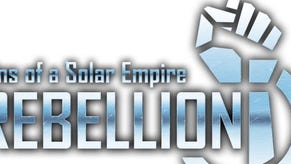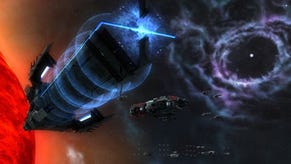Wot I Think: Sins of a Solar Empire: Rebellion
Hello, Space
The boys at RPS needed somebody who knew about rebellions for this review, so they called me in because I am Northern Irish and I once shot a gun. I thought, “This will be easy because it is a game about rebellion. There is even ‘rebellion’ in the title.” And then I discovered it was a game about SPACE rebellion, which is completely outside of my knowledge because I have not been into space even once. I thought, “I am in trouble now because I am not good at being in space.” I am currently playing a pen and paper role-playing campaign set in space. The character I rolled is so traumatised by life in space that every time there is a “stressful situation” he has to roll to see how he reacts. If I roll a one, I have to go through a psychotic breakdown.
I am not good at being in space. And here's wot i think of Sins of a Solar Empire: Rebellion.
I thought, “Hopefully there is enough rebellion to off-set this fact.” Then I played Sins of a Solar Empire: Rebellion and found out that it is barely a game about rebellion at all, which means it really should have gone to Space and Robots Correspondent, Jim Rossignol. But instead here we are. Me, with my lack of knowledge of the previous Sins games, forever unable to write “proper” reviews. You, fuming at your computer at the lack of spaceship facts, your Jean-Luc Picard figurine lying askew in a pot of yesterday’s hummus. For fuck sake, clean up.

Right. Sins of a Solar Empire: Rebellion is your bread and butter 4X real-time strategy game set in the cold, dark recesses of the universe. 4X refers to the genre’s famous ability to make you say “Ooo” precisely four times – no more, no less. You will note that Rebellion is a very pretty game. Even when everything is peaceful and combat is a distant afterthought, there are enough beautiful spacescapes to fill a whole corner shop full of intergalactic post cards. Far-off supernovae bathe your ships in white light, arms of galaxies corkscrew through your field of vision, bubbling red stars hiss and flare and burp like fierce gods with stellar heartburn, often frighteningly close. This is the first “ooo”.

It’s also one of the few games I have found myself zooming right in to single units just to watch them do their thing. Most strategies leave me unconcerned for close-ups of the action (I am too busy watching my fast-moving triangle hitting that big dumb rectangle to care about Roman soldier no. 1365) but again and again I made full use of the scroll wheel, viewing my battleships from every direction, thinking of them more like toys than war heroes. It helps that the zoom function is smoother than a brand of hot chocolate endorsed by Barry White. And although I actually had a good time taking OVER 200 screenshots, I don’t feel like any of them really do justice to the vision of stars blooming against the dark void, or the adorable little space-ballet your frigates do when they’re trying to get into formation.
As for how it plays, the whole thing is about as traditional an RTS as you can get. Resources are collected by colonising planets and building mineral extractors in orbit, or by jealously guarding the extractors at each space junction. The maps can be sprawling webs full of gas giants, asteroid belts, space junk, suns and wormholes. Or they can be a small, confined handful of rocky planets arranged in simple symmetry. If you’re not happy with them, there’s a map editor included, so fire away.

There are three races to fight as, also in keeping with tradition – the TEC are the testy humans, the Vasari are the alien scourge, and the Advent are the psychic lot who practice yoga and try to chat you up with talk of “Unity” and “Deliverance”. Each race has a rebel counterpart, with slightly different research options, which is new to Rebellion. Also new to the series is some tech for everyone and the introduction of huge capital ships called Titans. Titans, however, is an unimaginative name for these colossi but you can also rename almost anything in the game, so go ahead and call your Titan the ‘Space Bastard’.
The ludicrously expensive Titans feel like they should be part of the endgame on a map, but I discovered the hard way that they can be built a lot sooner than that and generally you and your foe(s) will get into that familiar arms race, each tying to build enough labs to “out-research” the other and launching frustrating hit-and-run raids at each other’s Titan Foundry.

Actually, the hit-and-run thing is interesting. I play almost every RTS the same way – dogmatically defensive. I layer every road with mines and barb wire, get the high ground whenever possible, wait in ambush for days rather than risk venturing out. In Rebellion, however, the AI was angry and hellish enough not to let me do that. Each race has the ability to spread their culture from planet to planet using propaganda platforms. These basically broadcast your team’s colour down the arms connecting every junction. God knows what’s in these broadcasts. Probably propaganda but possibly also annoying adverts with repetitive and memorable music. In any case, if the enemy’s culture is affecting your planet, the people begin to resent you and eventually they will rebel and chuck you out.
The enemy AI was fond of doing this to me. This meant my usual boarding-up-the-windows strategy had to be adapted to include horrid little guerrilla attacks on their propaganda platforms, in which I would have to distract their main armada with an attack on one side of the map while launching a smaller, specialised bombing run at the other side. Then there are the pirates to deal with. You have to constantly outbid the other players by making the bounty on their heads look more enticing than the one on yours, to avoid being hounded by pirate raids every ten minutes or so. All the while I was desperately scrounging together all my money to buy my own propaganda artists in the form of research.

And this research menu itself is one hell of a sprawl. It’s less a tech tree than a tech orchard. Each race has basically collected all the potential technology and specialities from previous games, along with upgrades to capital ships and starbases – gargantuan space fortresses that can also often double up as trade ports or a culture-spreading aid. I get paralysed with indecision when the “sandwich artist” in Subway asks me what bread I’d like. So the dozens of branches of tech was never going to be my strong point. But it will make many others very happy.

Each race has its own requisite endgame Big Guns to work towards. For the TEC and Vasari, these are literally really big guns, which rain down hell on distant planets or the structures orbiting them. The Advent, being awkward and speaking in a stupid echoey voice, has the Deliverance engine which allows them to spread their culture from afar, rather than just from an adjacent system. But of all the high-hanging fruit on the tech trees, my favourite is the Advent’s “Wail of the Sacrificed” which allows you to kill the ENTIRE POPULATION of one of your own planets so that enemy ships in nearby systems will feel the “psionic shock” of so many deaths and suffer damage as a result. Using this ability results in a huge scary witch face to appear above your planet, who looks like that banshee in Darby O’Gill and the Little People. Absolutely terrifying.

I didn’t play multiplayer because in my entire life I have never won an RTS online. People who play multiplayer RTS are good at thinking and pressing buttons very fast. I am not. Look how long it took me to type this review, for instance. The game has been out for WEEKS. But if the AI can give me so much grief on a normal setting, you’re likely in for some highly competitive games (and lengthy ones too – my shortest game was 4 hours 15 minutes and that’s only because I was so easily beaten (I am shit)). There is also a whole research area dedicated to diplomacy, allowing you to build pacts and have peace treaties with other players. I’d be interested to see whether such features could result in a long, fiendish backstabbing orgy – a game of Neptune’s Pride condensed into a single night. But I’m not going to be the one to test that. That would be silly.

So, yes. I like it. I knew I liked it when in the heat of a skirmish I upgraded my capital ship to include a boarding party who then captured a pirate frigate and convinced him to fight alongside our fleet, thereafter screeching “Trrrrrreasure, ye say!?” at every order I gave him. The thing is, Rebellion could easily be the kind of game which resulted in one of those boring IF THEN ELSE statements. IF reader played previous game AND likes previous game THEN reader will like Rebellion fine ELSE game too expensive. IF reader knows what’s good for them THEN reader will take advice ELSE sadness. You know, that kind of thing. But it’s a strong enough RTS to consider. I’d recommend it more heartily to newcomers if I didn’t already know that Sins of a Solar Empire: Trinity was on sale for half the price, which is likely to have a lot of the same content. I guess it really comes down to one thing: extra quids will get you Space Bastards.








